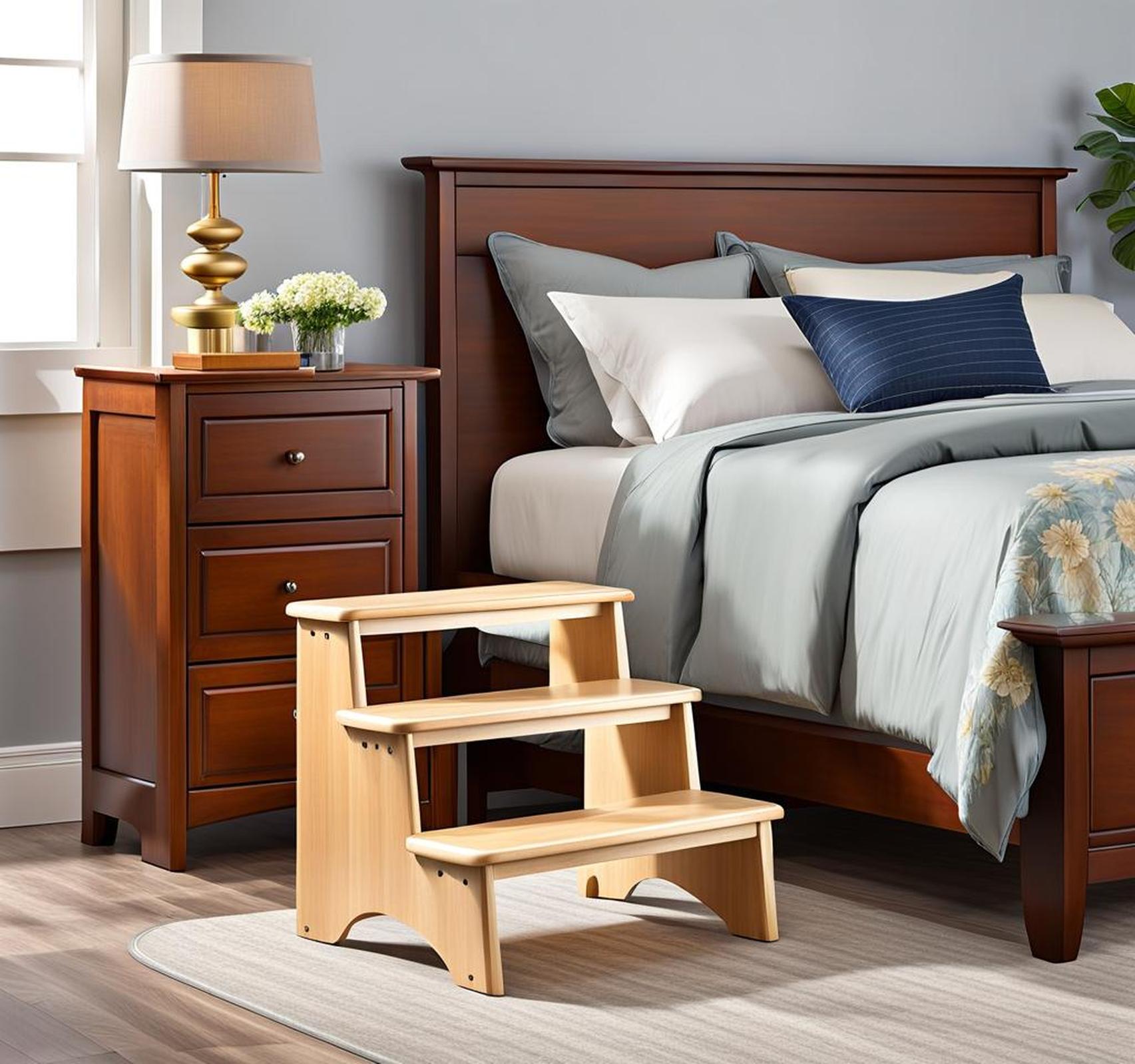As we age, simple tasks like getting in and out of bed can become increasingly challenging. Fortunately, bedside step stools provide a safe and supportive mobility aid for elderly individuals working to maintain their independence.
Thoughtfully designed step stools allow seniors to comfortably access their bed, while reducing the risk of slips or falls. Key features like grab bars, railings, and non-slip platforms empower older adults to take control of their daily routines with confidence.
Bedside Step Stools Provide Safe and Secure Access
One of the biggest benefits bedside step stools offer is securely getting in and out of a bed. They essentially act as small portable steps at the correct height, making the transition less stressful on aging joints.

The secure gripping supports also reduce the chances of losing one’s balance or footing while climbing. The risk of dangerous or painful falls trying to climb into bed is substantially lower.
Key Features For Safety and Stability
Not all step stools offer adequate stability for daily senior use. It’s important to look for key features that prioritize safety.
These include non-slip rubber platforms to prevent sliding, sturdy steel frames to support weight capacities over 250 pounds, and padded grab handles for comfort and security when climbing each step.
Adapting Step Heights to Physical Needs
Since bed heights can vary, adjustable step stools allow custom positioning. Seniors who have limited mobility or difficulty bending their knees can raise platforms higher to bring their bed within easier reach.
Being able to individually adapt step levels provides far greater independence. It also reduces the risk of strain or discomfort trying to climb fixed-height step stools.
Maintaining Mobility Around the Home
In addition to bed access, bedside step stools have multi-purpose potential for stability across daily living spaces like bathrooms or kitchens.
Their compact portable size allows seniors to safely step up to sinks for grooming, access cabinets for retrieving dishes, or even ease the process of getting in and out of cars.
Supporting Healthy Habits Through Accessibility
Having bedside step stools stationed around the home eliminates barriers to completing self-care tasks. Seniors avoid climbing on unsteady chairs or bending in ways that spark pain.
This accessibility allows them to freely move about to eat nutritious foods, bathe comfortably, or enjoy hobbies that nurture mental health – facets key for wellness.
Features For Secure and Practical Use
Great bedside step stools should check all the boxes for safety while offering added conveniences to improve quality of life.
Stability Musts
At minimum, every step stool should have an anti-slip tread, sturdy steel frame reinforced to hold over 300 pounds, and at least one grab handle for balance.
Other beneficial features include built-in lights that automatically illuminate steps at night, secured back rails for additional poise, and easy-grip handrails of textured foam.
Convenience Extras
- Wheeled bases make moving step stools between rooms simple.
- Foldable, compact designs are great for storage or travel use.
- Detachable backs offer customizable configurations.
- Some step stools even have integrated storage trays for small essentials like medications or inhalers.
Factor in space limitations, portability needs, and personal interests before deciding on extra conveniences.
Using Step Stools Securely
While bedside step stools vastly improve accessibility, seniors should still exercise safety precautions while using them.
Practice Proper Stepping Technique
Always have someone present to assist the first few times using a new step stool. Take gradual steps up and down while facing the seat – never descend backwards.
- Maintain three secure contact points at all times, whether the grab bar, railings, or step platforms themselves.
- Look forward, not down, when climbing. Bending neck backwards can impact balance.
- Step firmly in the middle of platforms to prevent tipping hazards.
Set Up Stable Support Areas
Ensure step stools have adequate clearance space before use. Identify sturdy, level setup points that will remain fixed and secure under weight shifts.
Remove trip hazards like rugs or cords from the nearby stepping area. Having cluttered spaces raises chances of accidents occurring.
Caring For Step Stools and Home Safety
With routine maintenance and household awareness, bedside step stools provide tremendous daily living support.
Regular Upkeep Guidelines
Be sure to check step stools before each use for signs of damage or excessive wear-and-tear. Loose bolts, debris stuck in joints, or frayed protective covers can lead to equipment failure.
Follow all weight restrictions, and refrain from using step stools for anything beyond their intended purpose. Proper use and care extends product lifespan.
Also regularly sanitize step surfaces, handrails, and storage trays to prevent the spread of germs.
Complementary Fall-Proofing Tips
Step stools minimize various fall risks, but creating secure home settings further protects seniors.
Simple adjustments like installing grip handlebars along walls, placing brightly lit motion sensor lights in dim hallways, or rearranging clutter from pathways all help make living worry-free.
By coupling step stools with proactive home modifications, elderly individuals can retain independence safely.
At the end of the day, bedside step stools deliver vital accessibility for the elderly demographic. Their thoughtful assistance allows older generations to comfortably navigate daily tasks on their own terms.
Reducing mobility limitations grants seniors greater freedom and confidence for everything from personal care to leisure activities.
Integrating compact step stools minimizes potential fall risks as well, creating peace of mind for both aging adults and family caregivers.
Bedside step stools are used by seniors to live active, independent lifestyles and reduce the risk of injury.
